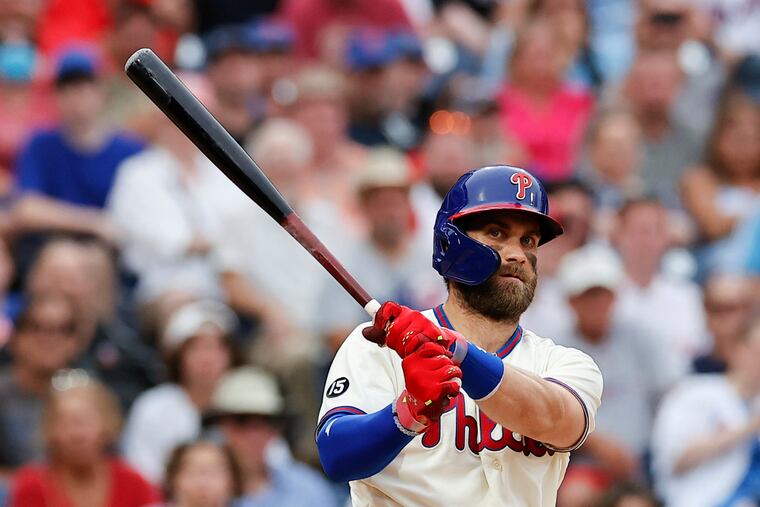Why would anyone pitch to Bryce Harper? Rare plate discipline fuels MVP bid.
Even without lineup protection, Harper rarely gets himself out, and when he does get a pitch in the zone, he's slugging .887 in the second half.

If ever the hottest hitter on the planet was going to get a few pitches in the strike zone, it would figure to be with two out and the bases empty in the first inning of a scoreless game.
Not so for Bryce Harper.
Batting in that situation Sunday night in New York, Harper saw five pitches from Mets left-hander Rich Hill. The first three were fastballs, up and away from the lefty-swinging Phillies star. The fourth, another elevated fastball, clipped the top of the zone for a called strike. Then, Hill uncorked a low-and-away curveball that was meant not to expressly walk Harper but to get him to chase it.
No dice. Harper laid off the breaking pitch and took his base.
“I never want to sit there and think I’m not going to get pitched to, or that a guy’s just going to throw four balls and I won’t have a chance to hit,” Harper said last weekend in New York. “I always want to be ready. I love to hit. But also I have to understand my zone and understand what makes me successful. Any chance I can get on base, if that’s walking, if that’s hitting a homer, if that’s hitting a single to the [left] side, that all corresponds with being a good player.”
» READ MORE: Phillies’ playoff push: Has Bryce Harper clinched MVP? Is Joe Girardi’s job safe?
It also has helped turn Harper into the presumptive National League MVP.
Consider this: When Harper does get a pitch to hit, he usually crushes it. He’s batting .380 and slugging .887 in the second half — .347 and .731 overall — on pitches in the zone.
So, why would a pitcher ever give him anything to hit, especially with Phillies cleanup hitters struggling behind him? Because Harper rarely gets himself out. Entering Tuesday’s game, his walk rate in the second half (20.6%) was greater than his strikeout rate (18.3%), and he had reached base at a .481 clip, second to Washington’s Juan Soto (.528).
“He has the ability to be selectively aggressive,” Phillies general manager Sam Fuld said. “When balls do tend to cover most of the plate, he tends to put the barrel on them, and when they’re not in the zone, it’s his ability to lay off. He stays within the zone, stays within himself. There’s not too many players on the planet that have that ability.”
Harper, who turns 29 next month, is clearly at the peak of his mash-the-good-pitches, lay-off-the-bad-ones powers. He has done this before. In 2015, his NL MVP season with the Washington Nationals, only 40.9% of the pitches he saw were in the zone. He hit .393 and slugged .808 against them, while chasing only 26.5% of pitches out of the zone, reaching base at a .460 clip, and walking (124 times) almost as often as he struck out (131).
But it’s exceedingly difficult to be that disciplined, especially when the opportunities are so limited. Harper, the rare teenage baseball phenom whose reputation preceded him to the majors, has been pitched to carefully since he made his debut in 2012. As a 19-year-old rookie, he swung at a career-high 32% of pitches out of the zone. In the ensuing seasons, his chase rate has ranged from 30.9% in 2014 to 25.6% in 2018. This year, it’s 25.7%.
“I feel like he’s never been a guy that would chase bad pitches,” Phillies pitcher Aaron Nola said. “Yeah, we’ll see him chase some curveballs in the dirt. A lot of lefties do that. But when he’s locked in, he’s really not chasing at all. It’s pretty cool to watch.
“And it puts a lot of stress on the pitcher. Because what he’s doing right now, guys make good pitches, he’s hit ‘em. They make good pitches [off the plate], he’s spit on ‘em. And the thing is, he’s not missing many pitches in the zone.”
Top Phillies prospect Bryson Stott has observed Harper for years. They both grew up in Las Vegas and are five years apart in age. Their mothers are friends. Harper and Stott watch college football together in the offseason and are roommates in spring training. They talk all the time. Yet Stott still marvels at Harper’s plate discipline.
» READ MORE: How Phillies’ Zack Wheeler reached 200 innings after pandemic-shortened 2020 season
“He walks a ton, he’s always getting himself into good counts, and I rarely ever see him get himself out,” Stott said. “That’s something that us younger hitters could learn.”
Maybe. As much as anything, though, it’s a mindset. Harper understands the strike zone and has a discerning eye. But he’s also willing to take what a pitcher gives him rather than always forcing the issue.
And it can make a difference. By not biting on that curveball from Hill on Sunday night, Harper extended the inning for J.T. Realmuto. When Realmuto lined a double to shallow center field, Harper recognized that the relay throw went to second base, sprinted through third-base coach Dusty Wathan’s stop sign, and scored the first run of the game.
“I never want to get too content with walking,” Harper said. “But in my whole career I’ve shown that walking and getting on base is very important to me. At this time, at this moment, where we’re at as a team [in the playoff race], if I can keep doing that, I’ll do that every day.”